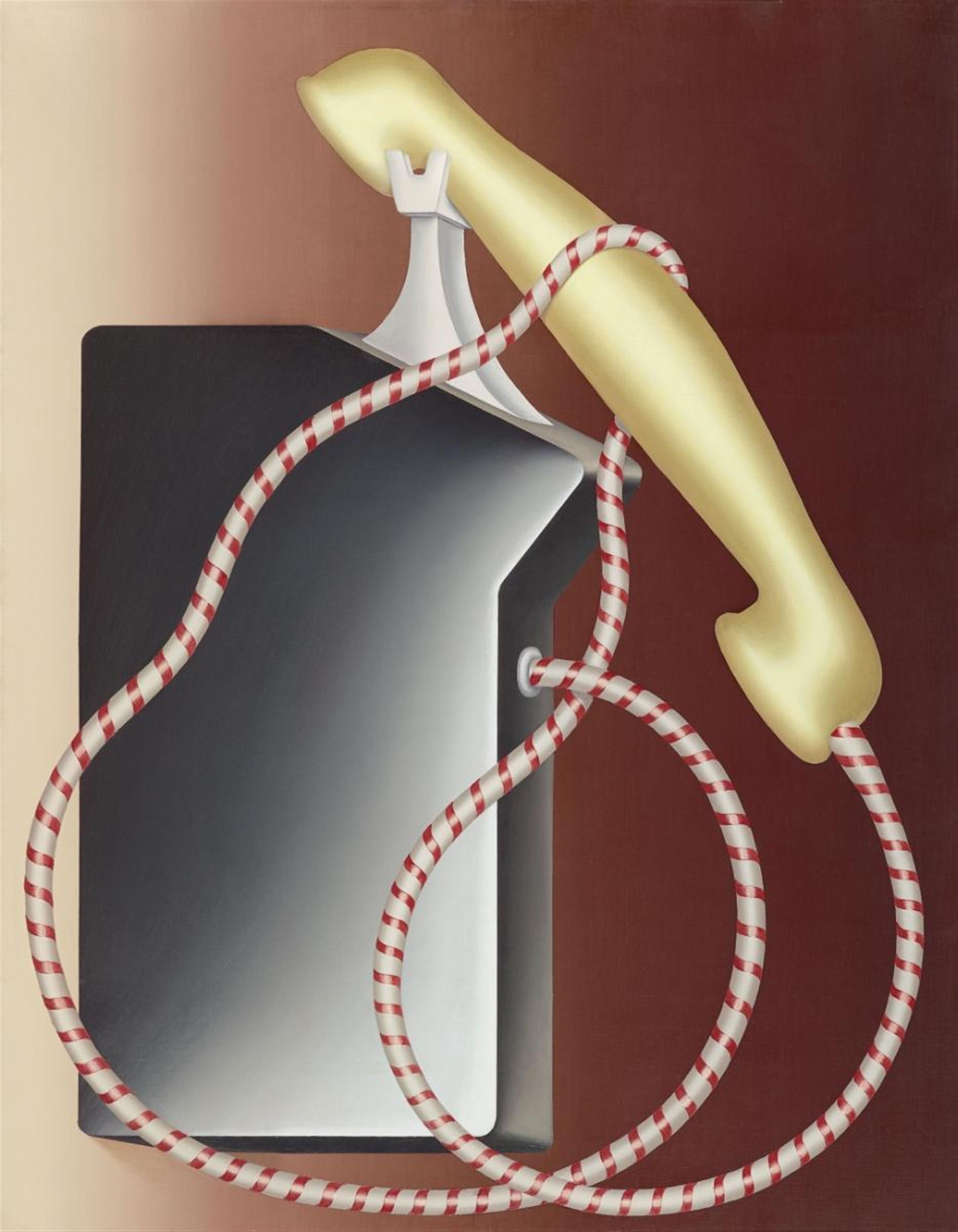Konrad Klapheck
Der Kuss
1966
Oil on canvas. 90 x 70 cm. Framed. The canvas verso signed and dated 'Klapheck 66' and the stretcher frame titled '(The Kiss) Der Kuss (Le Baiser)'.
Konrad Klapheck explored the seemingly trivial world of everyday objects in his distinctive paintings: typewriters, sewing machines and telephones were among the most important motifs in his thematic repertoire. The elevated, monumentalized depictions, together with his painterly precision, created a fascinating aura on the canvas.
From the beginning, Klapheck's painting took on a special position in post-war art in which his pictorial language hovered between Hyperrealism, Surrealism and Pop Art, but remained autonomous at the same time. He was very fortunate to find a supporter of his realistic object painting in his teacher Bruno Goller at the Düsseldorf Kunstakademie, in spite of the predominancy of Informal art of the time. National and international success quickly followed, with exhibitions with prestigious gallerists such as Rudolf Zwirner in Essen, Arturo Schwarz in Milan and Ileana Sonnabend in Paris and culminating in his first solo exhibition in the USA in New York at Sidney Janis, one of the leading patrons of American Expressionist and Pop Art artists. The exhibition was a great success: the Cologne collectors Peter and Irene Ludwig purchased two pictures, the foundation of their later Klapheck Collection, and many works came into the possession of the American businessman and collector Meshulam Riklis (cf. Kay Heymer and Beat Wismer, Klapheck (ed.), Bilder und Texte, exhib.cat. Stiftung Museum Kunstpalast, Düsseldorf 2013, p.168).
In an interview with Hans-Ulrich Obrist, Konrad Klapheck referenced a quote about the paintings of Jean-Auguste-Dominique Ingres which Klapheck believed also explained the character of his work: 'There is hardly any other artist who brings so much passion to his own pictures, but which is fire under a layer of ice' (cf. Interview, Obrist - Klapheck - Feldmann (2002), in: Kay Hemer and Beat Wismer (ed.), Klapheck, Bilder und Texte, exhib.cat. Stiftung Museum Kunstpalast, Düsseldorf 2013, p.127). Behind the seemingly objectivity of his object paintings Klapheck reveals always something personal and occasionally intimate, the so-called fire under the ice. The paintings become biographical. An important addition to each work is the title, which, often with a humorous wink, lent the depicted object a story and human characteristics. A good example of this is one of the earliest and well-known sewing machine pictures 'Die gekränkte Braut' (1957, the estate of the artist), which Klapheck painted after a temporary separation from his girlfriend and future wife Lilo. The pain of the girlfriend can be felt in the black machine with the lowered thread feeder. Whilst Klapheck's objects enable him to visualize pain, they also serve as the expression of one of lifes more positive themes: love. In the painting 'Der Kuss' the larger than life telephone seems to hover in an empty space between light and dark. As a result, the object is released from spatial and temporal associations and stands completely on its own. In many of his pictures the telephone is a medium to convey '(...) the voice of conscience and the commands of unknown powers (...)' (Konrad Klapheck, Die Maschine und ich, 1963, in: Wieland Schmied (ed.), Konrad Klapheck, exhib.cat. Kestner Gesellschaft, Hannover 1966, p.19). The machine also serves as a means of communication in 'Der Kuss', here however portraying a softly physical dialogue in which each part of the machine assumes a gender-specific role: the telephone box and the cradle seem feminine whilst the receiver and the cable suggest masculinity. The contact of the receiver with the cradle visualizes the kiss, whilst the cable implies a heartfelt embrace, softly coiled around the receiver and relaying the erotic connection between the telephone box and the receiver.
Catalogue Raisonné
Pierre 171
Provenance
Sidney Janis Gallery, New York (with label verso); Wolfgang Wittrock Kunsthandel, Düsseldorf (with label verso); private collection, Germany
Exhibitions
Rotterdam 1974 (Museum Boymans van Beuningen, with label verso), Brüssel 1974/1975 (Palais des Beaux-Arts), Düsseldorf 1975 (Städtische Kunsthalle), Konrad Klapheck, exhib.cat.no.54 with illus.
New York 1969 (Sidney Janis Gallery), Konrad Klapheck, 35 Paintings, exhib.cat.no.23 with illus.
Mailand 1968 (Galleria Schwarz), Konrad Klapheck, exhib.cat.no.9

